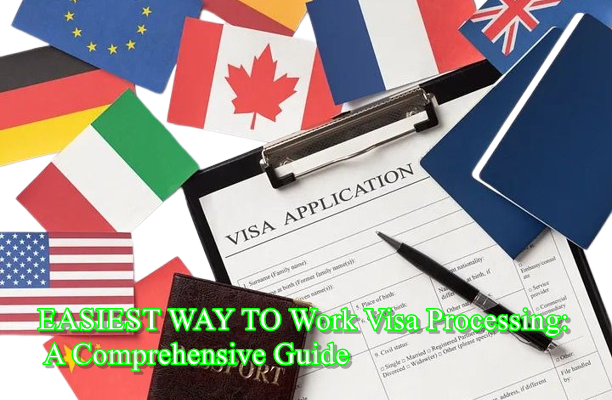EASIEST WAY TO Work Visa Processing:
A Comprehensive Guide
The processing of work visas depends on the option chosen and may be quite a subtle and detailed process which differs from country to country. Advanced learners do not pose a challenge because those who weakest link is the capability to comprehend how the immigration and visa system of various countries work stand to benefit from learning how to work Visa applications. Whether it is a short-term employment abroad or permanent working visa abroad, this publication will be of immense help to clarify how the work visa processing works, the stages, tips on how to proceed, EASIEST WAY TO Work Visa Processing: A Comprehensive Guide
1. What is a Work Visa?
A work visa is an official authorization that allows an individual to enter a foreign country for the purpose of employment. It grants the holder permission to work in that country for a specified period, usually under certain conditions that may include restrictions on the type of work, the duration of employment, and the employer, EASIEST WAY TO Work Visa Processing: A Comprehensive Guide.
Work visas come in several types, including temporary visas for short-term employment, skilled worker visas, seasonal work visas, and permanent work visas for individuals who intend to stay long-term. Each visa has different requirements and eligibility criteria.
2. Types of Work Visas
Different countries offer various types of work visas based on the purpose and nature of the employment. Below are some of the most common types:
a. Temporary Work Visas
Temporary work visas allow individuals to work in a foreign country for a limited time, typically tied to a specific job or employer. These visas are usually issued for seasonal work, short-term contracts, or internships.
- Examples:H-2B Visa (U.S.) – For temporary non-agricultural workers. Working Holiday Visa – Available in countries like Australia, New Zealand, and Canada for young travelers looking to work temporarily.
b. Skilled Worker Visas
Skilled worker visas are issued to individuals with specialized skills that are in demand in the host country. These visas are often part of a government program aimed at attracting skilled labor to fill workforce shortages.
Examples:
H-1B Visa (U.S.) – For skilled professionals, especially in tech and engineering .Tier 2 Visa (UK) – For skilled workers with a job offer from a UK employer. Skilled Migration Visa (Australia) – Allows skilled workers to live and work permanently in Australia.
c. Seasonal Work Visas
Seasonal work visas are intended for individuals who take up jobs that only occur during specific seasons, such as agriculture, tourism, or hospitality.
Examples:
H-2A Visa (U.S.) – For temporary agricultural workers.
Seasonal Worker Visa (UK) – For workers in industries like agriculture and hospitality.
d. Permanent Work Visas
Permanent work visas, also known as immigrant work visas, allow individuals to live and work in a foreign country indefinitely. These visas often lead to permanent residency or citizenship.
Examples:
Employment-Based Immigrant Visas (U.S.) – Such as EB-2 and EB-3 visas. Skilled Independent Visa (Australia) – Permanent residency for skilled workers.
3. Eligibility Criteria for a Work Visa
The eligibility requirements for work visas differ depending on the type of visa, the host country, and the applicant’s job profile. Here are the common criteria most countries consider:
a. Job Offer
In most cases, you must have a valid job offer from an employer in the country you are applying to work in. The employer often plays a significant role in sponsoring your visa.
Note: Some countries, like Canada under the Express Entry system, allow certain skilled workers to apply for visas without a pre-existing job offer, based on points-based assessments.
b. Skills and Qualifications
For skilled worker visas, applicants are usually required to demonstrate that they have the skills, education, and work experience relevant to the job they are applying for.
Example: For the U.S. H-1B visa, applicants must hold at least a bachelor’s degree or its equivalent in a specialized field.
c. Employer Sponsorship
Many countries require that the employer acts as a sponsor for the applicant, meaning the company must be approved to hire foreign workers and agree to specific conditions, such as offering wages comparable to those of domestic workers.
d. Health and Character Requirements
Most work visa applicants must pass a health check to ensure they do not pose a public health risk to the country. Additionally, applicants are often required to submit police clearance certificates or background checks to show they have no criminal record.
e. Language Proficiency
In some countries, proficiency in the local language is a requirement for certain types of work visas, particularly those leading to permanent residency. For example, Australia and Canada often require English language proficiency tests (IELTS, TOEFL, etc.) as part of their skilled worker visa applications.
4. The Work Visa Application Process
Applying for a work visa involves several steps, and it is important to ensure that each step is followed accurately to avoid delays or rejections. Below is a step-by-step guide:
a. Secure a Job Offer
The first step is to secure a job offer from a company in the country you wish to work in. In most cases, the employer must confirm that they are willing to sponsor your work visa. Some countries require the employer to prove that they could not find a suitable local candidate for the position before hiring a foreign worker.
b. Gather Required Documents
Once you have a job offer, you need to gather all the necessary documents for your visa application. The documents required will vary by country and visa type but typically include:
A valid passport
Completed visa application form
Job offer letter or contract from the employer
Proof of qualifications (degrees, certifications, etc.)Proof of relevant work experience
Employer sponsorship documents
Medical certificate
Police clearance certificate (criminal background check)
c. Submit the Application
Once you have gathered the required documents, you will need to submit the visa application. This is usually done online through the immigration website of the country you are applying to, although some countries may still require paper-based submissions through their embassies or consulates.
Tips for Submission:
Double-check that all forms are completed correctly.
Ensure all documents are translated into the required language, if applicable.
Pay the application fee and keep the receipt for reference.
d. Attend an Interview (if required)
Some countries require visa applicants to attend an interview as part of the visa processing. The interview is usually conducted at the embassy or consulate of the country you are applying to and may involve questions about your job offer, qualifications, and the purpose of your visit.
Common Interview Questions:
What is the nature of the job you will be performing? Why did you choose this job in this particular country ?How will you support yourself financially during your stay?
e. Wait for a Decision
After your application is submitted, the waiting period begins. Processing times vary by country, visa type, and the volume of applications being processed. Some countries offer expedited processing for an additional fee, but it is important to apply well in advance of your planned start date to avoid delays.
f. Receive Your Visa
Once your visa application is approved, you will receive your work visa. This visa may be a sticker in your passport, or in some countries, it might be a separate visa document. The visa will specify the duration of your stay, the employer you are authorized to work for, and any other conditions, such as whether you can bring family members with you.
5. Common Challenges in Work Visa Processing
Work visa processing can be fraught with challenges, especially for first-time applicants. Here are some of the most common obstacles people face:
a. Strict Quotas
Many countries impose quotas or caps on the number of work visas they issue each year. For example, the U.S. H-1B visa is subject to an annual cap, and the demand often exceeds the available visas, leading to a lottery system for allocation.
b. Complex Documentation Requirements
Work visas typically require extensive documentation, including employment contracts, qualifications, and proof of work experience. Missing or incorrect documents can lead to delays or rejections.
c. Lengthy Processing Times
In some countries, work visa applications can take several months to process, especially during peak application seasons. This can disrupt plans and cause applicants to miss job start dates.
d. Sponsorship Difficulties
Not all employers are willing or able to sponsor work visas, as it can be a costly and time-consuming process. In some cases, employers may be required to prove that no qualified domestic workers were available for the job.
6. Tips for a Successful Work Visa Application
To increase your chances of success in the work visa application process, follow these tips:
a. Start Early
Begin the process as soon as you secure a job offer. Work visa processing can take time, and the earlier you start, the more time you’ll have to gather documents and resolve any issues.
b. Seek Professional Assistance
Consider hiring an immigration lawyer or a visa consultant, especially if your case is complex. They can guide you through the process, help you avoid common mistakes, and improve your chances of approval.
c. Keep Track of Deadlines
Missing a deadline can result in your application being delayed or rejected. Make sure you are aware of all the submission deadlines and follow up regularly on the status of your application.
d. Prepare for the Interview
If your visa requires an interview, practice answering questions about your job, qualifications, and purpose for working in the country. Being well-prepared will help you present yourself confidently and clearly.
7. After You Receive Your Work Visa
Once your work visa is approved and you have entered the country, it is important to adhere to the conditions of your visa. Here are some key points to remember:
a. Stay Within the Terms of Your Visa
Work visas often have specific conditions attached, such as the employer you can work for, the job you can do, and the duration of your stay. Violating these conditions can result in deportation or future visa rejections.
b. Renew Your Visa if Necessary
Some work visas are temporary and will need to be renewed if you wish to continue working in the country. Be sure to apply for renewal well before your current visa expires.
c. Explore Permanent Residency Options
If you wish to stay in the country long-term, explore options for transitioning from a work visa to permanent residency. Many countries have programs that allow skilled workers to apply for permanent residency after a certain period of time working in the country.
Conclusion
Work visa processing can be a complex but rewarding experience, opening the door to international career opportunities and personal growth. Whether you are applying for a temporary work visa, a skilled worker visa, or a permanent work visa, it is important to understand the requirements, prepare thoroughly, and seek professional help if needed. By following the steps outlined in this guide, you will be well-equipped to navigate the work visa process successfully and begin your journey toward working abroad.




